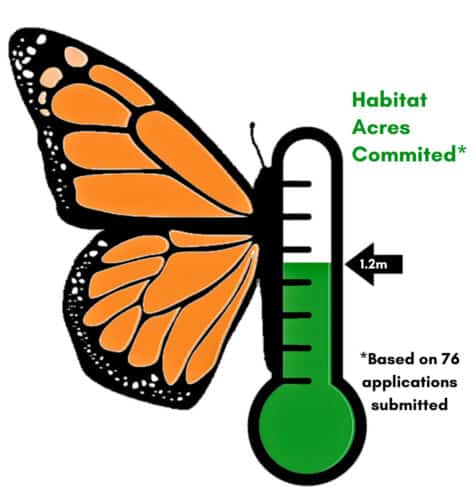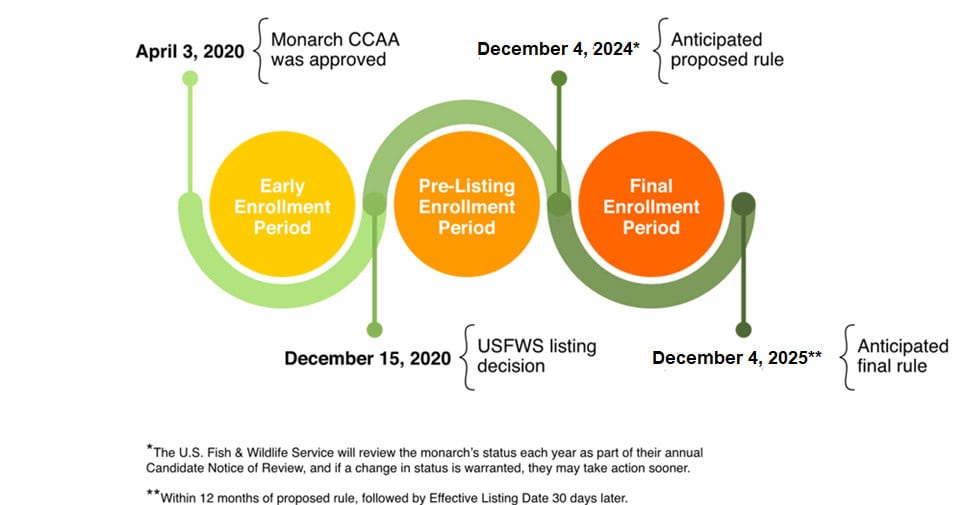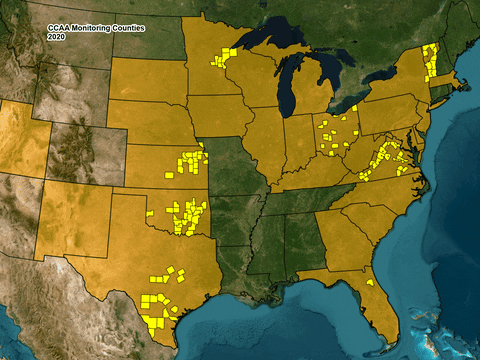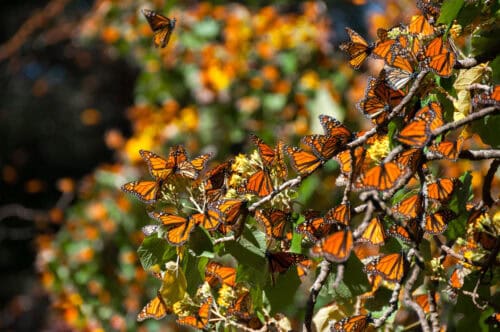Make a Difference. Enroll Today!
Energy and transportation lands play a vital role in conserving monarch habitat across the U.S., as noted in the ‘all hands on deck’ paper (Thogmartin et al. 2017). By enrolling in the Monarch CCAA, energy companies and transportation organizations voluntarily commit to implementing conservation measures on a portion of their managed lands.
Ready to Make Your Commitment?
To enroll in the Monarch CCAA, a company or organization (referred to as an “Applicant”) must meet the following eligibility requirements:
- Be an agency or company that manages lands associated with energy and transportation uses. Eligible lands include (but are not limited to) lands related to electric power generation, electric transmission and distribution, transportation infrastructure, oil and gas operations, and rail corridors.
- Operate within the monarch butterfly’s migratory and breeding range across the lower 48 states of the U.S., referred to as the “Covered Area”.
- Have authority and control to implement conservation measures on enrolled lands through property rights such as fee-title ownership, land management and access permits, easements, leases, or statutory authority.
- Agree to follow the application process and meet all compliance obligations outlined in the Monarch CCAA.

Certificates of Inclusion Issued to Date
How to Enroll
Ready to make your commitment to monarch butterflies and improving biodiversity? Here’s how to apply to the Monarch CCAA:
- Contact the Program. Start by reaching out to the Program Administrator at the University of Illinois Chicago. This initial conversation helps confirm your eligibility, discuss the lands you wish to enroll, review applicable conservation adoption rates, and answer any questions about the Agreement.
- Prepare the Application. The applicant then compiles a detailed application package including:
- A description of the lands proposed for enrollment, including their use, estimated acreage, and calculation of “adopted acres” (where conservation measures will be applied).
- Identification of “covered activities” (e.g., routine land management, maintenance, and modernization activities) that may result in incidental take of monarch.
- Maps or GIS data showing the enrolled lands and associated property interests (e.g., fee-owned, easement, leasehold, etc.).
- A description of the specific conservation measures to be implemented.
- A proposed schedule for habitat monitoring.
- An acknowledgment that an implementation plan will be developed within one year of receiving their Certificate of Inclusion.
- A full list of other federally endangered, threatened, or proposed species and critical habitat present on their enrolled lands, along with measures to avoid or minimize impacts.
- Acknowledgement of compliance with applicable state and federal laws.
- Submit Application. The completed application package is submitted to the Program Administrator for review. The application will then be reviewed, in coordination with the U.S. Fish and Wildlife Service, for completeness and consistency with the Monarch CCAA.
- Certificate of Inclusion Issuance. Once the application is verified and approved, the Program Administrator issues a Certificate of Inclusion to the applicant under the Service-approved Enhancement of Survival Permit.
- Formal Partner Status and Fee Payment: The applicant becomes an official “Partner” under the Monarch CCAA once the Certificate of Inclusion is signed by both the applicant and the Program Administrator. Partners must pay the required annual administrative fees to the Program Administrator within 90 days of the Certificate execution, or as otherwise agreed upon with the Program Administrator.
- Fulfill Commitments. Following enrollment, the partner is responsible for implementing their committed conservation measures, tracking their activities (including acreage, dates, and locations), conducting habitat monitoring, and submitting annual compliance reports to the Program Administrator.
Documents to Get You Started on Your Application
The following resources will help guide you through the application process for enrollment in the Monarch CCAA.
- Monarch CCAA Application: The official application form detailing the information required for enrollment in the Monarch CCAA.
- Monarch CCAA Application Checklist: A comprehensive checklist outlining the resources and information needed to complete your CCAA enrollment.
- Section 7 Guidelines for Application Preparation: A step-by-step guide to help applicants provide sufficient documentation to meet U.S. Fish and Wildlife Service requirements for Section 7 compliance verification.
- Guidance for Determining Enrolled Lands and Covered Activities: Recommendations for identifying which parcels of land should be included in enrolled acres and what activities are covered under the CCAA.
- Conservation Agreements Admin Fee Calculator: This spreadsheet helps applicants and current partners estimate their annual administrative fees for enrollment in the Monarch CCAA and/or Bumble Bee CBA.
What is the Timeline for Enrollment?
The Monarch CCAA enrollment period is divided into three phases, as shown below. The early enrollment period provided an opportunity for energy companies and transportation agencies to make conservation commitments that would be considered by the U.S. Fish & Wildlife Service (USFWS) during their listing decision. On December 15, 2020, the USFWS announced that the monarch is warranted but precluded for listing, which means that it is now a candidate species. The U.S. Fish and Wildlife Service has a settlement agreement for publishing a proposed rule if still warranted by December 4, 2024. If the monarch is listed as threatened or endangered, the CCAA will remain open for enrollment until the effective listing date, typically 30 days after the final rule. All applications must be submitted prior to the effective listing date in order to be eligible to enroll in the CCAA.

But don’t wait! Enrollment into the Monarch CCAA provides a number of immediate benefits, your conservation commitments will:
- Provide much needed habitat to the monarch butterfly and could potentially influence the listing decision
- Provide immediate regulatory certainty to your organization and avoid potential gaps in regulatory coverage in the event the monarch is listed sooner than expected
- Demonstrate your organization’s leadership in monarch conservation
- Build momentum across the industry for habitat conservation on energy and transportation lands
- Ensure the success of this unique, cross-sector partnership
Monitoring Conducted for the Monarch CCAA
See how the monitoring efforts have grown since the first year the Monarch CCAA was implemented in 2020! CCAA Partners report on the presence of milkweed and other important data points through biological effectiveness monitoring in order to evaluate if program is providing monarch habitat on CCAA partners’ adopted acres. Many Partners go above and beyond program requirements by monitoring additional plots and utilizing the Pollinator Scorecard, a flexible, multi-tiered tool which aims to establish a consistent monitoring methodology for pollinator habitat on energy and transportation rights-of-way. The graphic below showcases the counties where monitoring has occurred nationwide from 2020 to 2024.

For more information about implementing the CCAA at your organization, visit the Monarch CCAA Toolkit. Have questions? Contact us below.
Resources
Restoring Monarch Butterfly Habitat in the Midwestern US: ‘all hands on deck’
Guidance: Enrollment Timing Considerations

